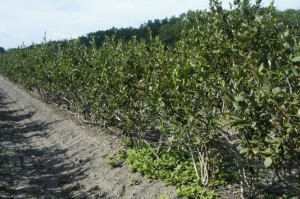Stinger has been labeled for weed control in stone fruit orchards, including peaches, nectarines, apricots, plums, and cherries. The weeds controlled fall into two botanical plant families, composites and legumes. Common composite weeds found in our orchards include Canada thistle and other thistles, goldenrod species, aster species, common dandelion, mugwort (wild chrysanthemum), horseweed (marestail or stickweed), and ragweed species. Legume weeds include vetch species and clover species.
The maximum labeled rate of Stinger per application is one-third of a pint per acre (O.125 lb ai/A), and the maximum rate per year application is two-thirds of a pint per acre (O.25 lb ai/A), but the rate needed varies, depending on the target species. Two fluid ounces per acre (0.047 lb ai/A) will control seedling annual weeds such as common ragweed and annual vetch. Three to four fluid ounces per acre (0.070 to 0.094 lb ai/A) are needed to control perennial clover species, horseweed, and groundsel. Most other susceptible perennial weeds require the full rate of one-third of a pint per acre (0.125 lb ai/A).
Optimum results controlling deep rooted and hard to control perennial weeds, including Canada thistle, perennial asters, goldenrod species, and mugwort (wild chrysanthemum) will be obtained if the Stinger application is split. Apply one third of a pint per acre Stinger in late April when the weed is emerging in the spring. Some weeds can “survive” for months on established existing foliage even though Stinger suppresses all new growth. Tank-mix with Gramoxone to increase the spectrum of weeds controlled and kill existing foliage of perennial asters, goldenrod species and mugwort. Some weeds, especially mugwort, can “survive” for months on established existing foliage even though Stinger suppresses all new growth. Be sure to spray adjacent sod and row middles as well as the weed free strip under the blueberries. Mark the treated rows.
The application of Stinger timed to match the emergence of the perennial weed in the spring coincides with the time of year when the carbohydrate food reserves in the plant are at the lowest point. Treatment at this time reduces the weed’s chance of recovery and survival.
Apply another one third pint of Stinger to the marked rows, or sections of rows immediately after harvest in mid summer. No growth of the target weed may be observed at the time of the second application. Spray the second application even though no growth of the target weed is evident. The second application is essential for the elimination of the hard to kill established perennial weeds. If the second application is skipped, expect to see the weed re-emerge in late August or September. Time all applications to maintain a 30 day PHI (PreHarvest Interval).
Stinger is both a postemergence foliar absorbed herbicide and a residual herbicide. The initial twisting and curling observed after application to susceptible species is due to the foliar absorbtion. Control of established perennials is due to residual Stinger in the soil which prevents regrowth from the roots. In certain species such as mugwort, Stinger prevents regrowth but does not kill the mature leaves. The plant will survive unless another herbicide such as Gramoxone or glyphosate is used to defoliate the plant.
Do NOT apply Stinger in a hand held sprayer used to “spray until wet”. Stinger is a residual herbicide that must be applied on a rate per acre basis. When treating “patches” of perennial weeds, apply the recommended rate per acre with a calibrated sprayer. Treat ten to fifteen feet beyond the weed “patch” on all sides. Spray the sod or row middles adjacent to the weed “patch” in the row.


